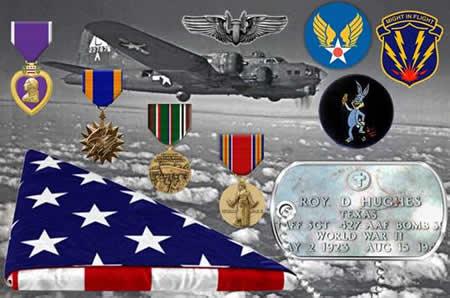 Staff Sergeant Roy David Hughes, Sr.
Staff Sergeant Roy David Hughes, Sr.
United States Army Air Forces, World War II
427th Bomb Squadron, 303RD Bomb Group
August 14, 2018 - The 303rd Bombardment Group (Heavy) “Hells Angels” was activated on February 3, 1942 at Pendleton Field, Oregon and assembled at Gowen Field, Idaho 8 days later where flight training was conducted until June 12, 1942. The Group then moved to Alamogordo Field, New Mexico for advanced flight training and on to Biggs Field, Texas to prepare for deployment overseas. The ground echelon sailed to the United Kingdom aboard the Queen Mary in September 1942 arriving at Greenock UK 5 days later. Meanwhile the flyers flew to Dow Field Maine and began their deployment. The entire group was reunited at Molesworth, UK and flew its first combat mission November 17, 1942.
A month earlier 19-year-old Roy David Hughes, born in Campti, Shelby County, Texas, said goodbye to Joyce, his wife of five months and parents Joseph Elijah and Mary Leona Brittain Hughes. He enlisted in the Air Corps in Houston, Texas October 27, 1942 and entered training to be an aerial gunner. Roy caught up with the 303rd Bomb Group in the summer of 1944 and was assigned to the 427th Bomb Squadron. His first combat mission was the 213th for the group and he climbed aboard B-17G # 42-102569 aka “Miss Lace” as the top turret gunner on July 28, 1944. 2nd Lieutenant Robert S. McCall was the pilot and the crew consisted of nine total. Thirty-seven B-17’s made up the group with its target as Leuna Synthetic Oil Plant, Merseburg, Germany. The 8 hour and 10-minute mission (4 hours, 20 minutes over enemy territory) was carried out without an enemy fighter in sight.
Evidently the bombing didn’t get the job done as the following day they had the same target. This time Sergeant Hughes joined the crew he would remain with headed by Pilot, 2nd Lieutenant Robert W. Davis. Another 8 ½ hour mission proved successful although they did run into heavy flak and enemy fighters. Friendly P-51’s joined in and dogfights ensued.
Missions that followed with Lieutenant Davis’s crew; July 31, 1944, Aero Engine Works Munich, Germany, 8 hours, 25 minutes; August 1, 1944, Airfield at Orleans/Bricy, France, 5 hours 55 minutes; August 3, 1944, Military Installation at Fresnoy, Crepieul and Fressin, France, 4 hours; August 4, G.A.F. Experimental V-Rocket Station, Peenemunde, Germany, 8 hours, 50 minutes; August 5, Flers, Cousbronne, Flefs, Fleury, Crepieul, Fressin and Coxyde, France, 3 hours, 40 minutes; August 6, Aero Engine Works, Genshagen, Germany, 8 hours, 30 minutes; August 8, Caen Area, France, 4 hours, 35 minutes; August 12, Railroad Marshalling Yards, Metz, France, 8 hours, 45 minutes; August 13, Road Junction at Eureux-Bernay, France, 4 hours, 55 minutes; August 14, Airfield at Stuttgart Echterdingen, Germany; 7 hours, 40 minutes.
The 303rd Bomb Group’s 229th combat mission came on August 15, 1944 against an airfield near Wiesbaden, Germany. This day would also be Sergeant Roy Hughes’ 13th and last mission. Flying with Lieutenant Davis aboard the B-17 dubbed “Flying Bison” the group dropped a total of 147 1,000-pound M43 and 146 500-pound M17 incendiary bombs on the primary target. At 1148 hours, about 45 miles from the target on the return journey, the formation was attacked by 20 to 25 German FW-190 fighter aircraft. Friendly fighter support was nowhere in sight. The enemy attacked from out of the sun, giving no warning to the formation of 39 B-17s. The Flying Bison sustained numerous hits, causing Lt. Davis to lose altitude from 22,000 to 17,500 ft. and become separated from the rest of the formation. Fighting to get the aircraft back on an even keel, Lt. Davis began to take stock of his aircraft and crew. The Engineer, Sgt. Roy D. Hughes, had been instantly killed by a 20mm cannon shell while flying in the waist gunner position. Radio Operator Sergeant E. R. Gorman was wounded in his right ankle and Tail Gunner Sergeant Foley in the leg and foot. The Navigator, Lt. G. L. Lange, and Bombardier, Flight Officer W. Bryan, were sent back to the waist to administer first aid. Aircraft damage was very severe. Upon reaching the English Channel, Lieutenant Davis, struggling to maintain altitude and saw that they could reach England. He put the B-17 in a shallow dive that increased air speed to 185 mph while crossing the Channel at 15,500 ft. Upon reaching Molesworth, he notified the tower of his injured crewmen. The tower had Lieutenant Davis make two runway passes. With no rudders he made a long approach to a perfect landing. When the wheels touched the ground, he noticed that the left wheel tire was flat. Only with extremely keen judgment and control did he prevent further disaster. The aircraft was damaged to such an extent that no attempt was made at repairs. It was salvaged for parts in the boneyard. (Crew mission list 229, August 15, 1944).
The 303rd Bomb Group would go on to complete 364 combat missions, the last on April 25, 1945. The last mission of the Lieutenant Davis Crew ended in tragedy when his B-17 collided with another shortly after takeoff and crashed near Wenlock, Shropshire, England on November 9, 1944.

Roy Davis Hughes, Jr. would be born December 4, 1944 and never know his father. Roy Sr. was initially buried in England with his remains arriving in Houston, Texas four years later in August 1948. Services were held at the Fogle West Chapel with burial in the Brookside Memorial Park, Houston, Texas. His father Joseph a World War I Veteran, mother Mary and brother Lloyd also a World War II Veteran are buried with him at Brookside.

(Sources: Ancestry.com, August 2018; Champion Newspaper, Center, Texas 8/5/1948; www.303rdbg.com; Find A Grave Memorial 19415676).









